Veteran photos and military biographies – Honor Flight #55
Every North Country Honor Fight carries veterans with different military backgrounds. Flight #55 included a medic, infantrymen, supply, maintenance, communication, and electronics specialists, forward artillery observers, a helicopter mechanic, a cook, a fighter pilot with 22 kills, and the Distinguished Flying Cross, a jet engine mechanic. Some suffered wounds and sicknesses, the effects which remain with them today. It takes all those specialties and expertise to have a strong national defense. These veterans should be proud of their service. The North country is proud of them and thanks them for their service.
The Peru Gazette photographed the veterans just before the Send-Off Ceremony began. Janet Duprey provided the biographies.
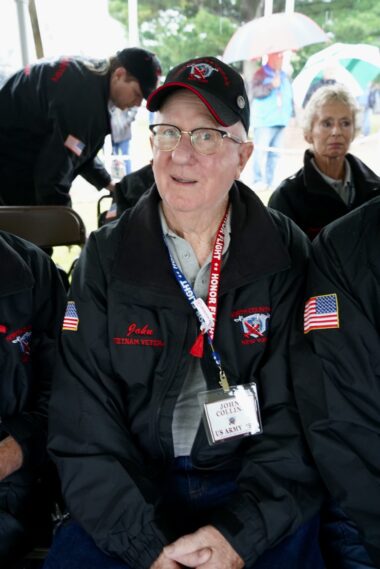 John Collins, U.S. Army, 1966-1968 – Vietnam
John Collins, U.S. Army, 1966-1968 – Vietnam
John was drafted and had basic and AIT Communications training at Fort Hood. Deployed to Vietnam, arriving in Chu Lai, John saw prisoners with their heads covered. John knew the War was real. John ran communications lines between artillery units. After a day of hand-to-hand fighting, the base was nearly overrun, so the next morning, they moved equipment. When told to move, they moved! One night during the Tet Offensive, soldiers sat on top of bunkers, watching shelling overhead attack the base beyond. Receiving a Mail Call was huge. John saw Bob Hope and Raquel Welch. She was much better than Bob! In Seattle, John drank milk for the first time in a year.
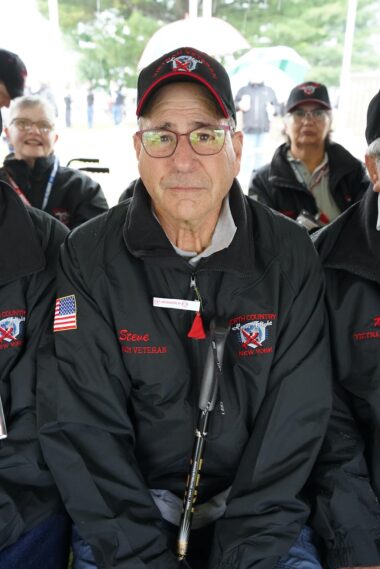 Steven DeMaroney, U.S. Army, 1968-1969 – Vietnam
Steven DeMaroney, U.S. Army, 1968-1969 – Vietnam
Drafted, Steve had basic training at Fort Dix and AIT training at Fort Poe. Deployed to Vietnam, Steve was an Infantry Unit Squad Leader. During a briefing, Steve fell asleep; the General told him he’d be demoted. Steve said, ‘Honestly, General, it was boring.’ No demotion.
In 1969, Steve was wounded by shrapnel due to land mines populated by the North Vietnamese Army. Steve was airlifted by MASH to Japan and then Korea. Before Steve’s parents knew he was wounded, they received his Purple Heart. Steve still suffers from shrapnel in his legs. In Korea, assigned to train duty, Steve checked recruits’ haircuts, sending many across the street for military haircuts.
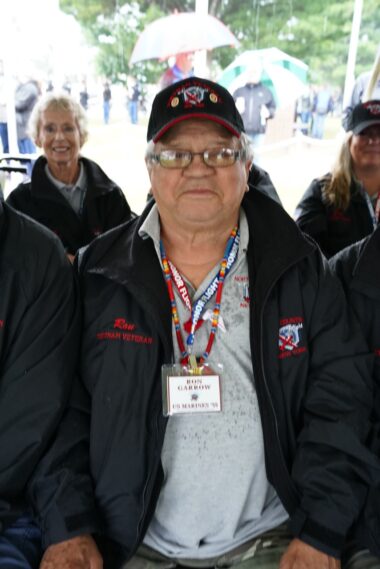 Ronald Garrow, U.S. Marine Corps, 1961-1966 – Vietnam
Ronald Garrow, U.S. Marine Corps, 1961-1966 – Vietnam
In Vietnam, Ron was a forward observer for heavy artillery fire, calling in air strikes. It was hard to watch the results. Handling an M-60 machine gun in swamp water up to his chest, Ron heard water slushing. Ron asked, ‘Who’s there?’ There was no answer. Ron cocked his gun and heard, “It’s me,” the Sergeant checking on his troops.
Ron was good friends with Levi Oakes, the Code Talker. A Native American, other Marines called Ron “Chief.” Ron is an Honor Flight motorcycle escort but does not have a bike today. Ron sees this day as a thank you and a welcome home he never received. We promise Ron a great day!
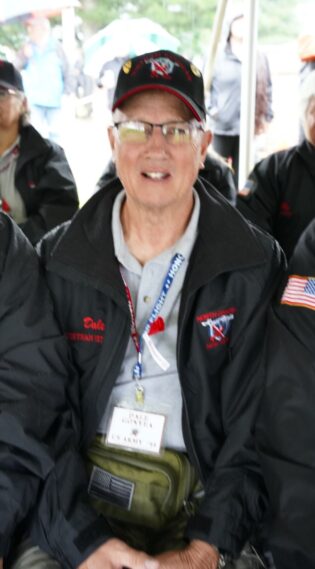 Dale Gonyea, U.S. Army, 1969-1978, 1979-2000 – Vietnam
Dale Gonyea, U.S. Army, 1969-1978, 1979-2000 – Vietnam
Dale had basic training at Fort Dix, AIT Technical School at Fort Eustis. Sent to Quan Loi, Vietnam, Dale was with Aviation Unit Bravo Troop 1st-9th Air Cav. A helicopter mechanic, Dale fixed (LOACH) light observation helicopters used as bait for enemy fire. Dale had perimeter night guard duty searching for enemy mortar and rocket attacks. Dale and Deanna married five days before he went to Vietnam, and she sent letters daily. Dale spent 20 years in the Medical Reserve Unit, Malone. Dale has received many awards for his 28 years of service to our Country.
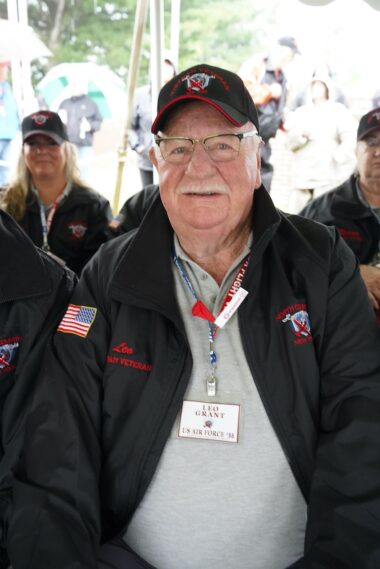 Leo Grant, U.S. Air Force, 1966-1970 – Vietnam
Leo Grant, U.S. Air Force, 1966-1970 – Vietnam
Leo enlisted and went to Amarillo for supplies, maintenance, and tech school training. In Japan, a radar tower location almost as large as the base was hit by an earthquake and disintegrated the causeway, leaving the radar station stranded. Leo went to Thailand north of the DMZ, across the river from Vietnam. Eighty percent of air strikes happened there. One night, the Vietcong cut the hydraulic lines on the aircraft. An alert was called, so the troops were sent to the bunkers. Leo wouldn’t go in because of the snakes. The barracks were covered with mosquito nets to keep out rats. With ten months left, Leo still handled parts and scheduling.
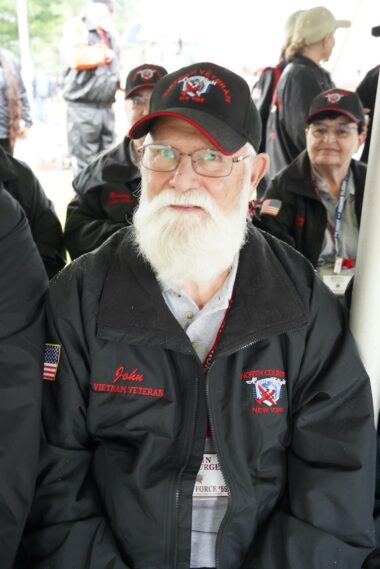 John Homburger, U.S. Air Force, 1969-1971 – Vietnam
John Homburger, U.S. Air Force, 1969-1971 – Vietnam
A draft letter for the Marines had John join the Air Force. At Lackland Air Force Base, John had tech school training as a Jet Engine Aircraft Mechanic working on the F-111s. At Nellis Air Force Base, John contracted Chron’s Disease. Sent to Tampa, John saw a specialist and spent two months in the hospital. John worked on everything that flew: Air Force, Marines, Navy, and Army. On ‘down-time‘, John chased armadillos off the flight line. Driving a ‘follow-me truck,’ John took a shortcut in a restricted area, was stopped, and laid out with guns drawn; his supervisor arrived. John didn’t do that again. Due to Chron’s Disease, John received a disability discharge.
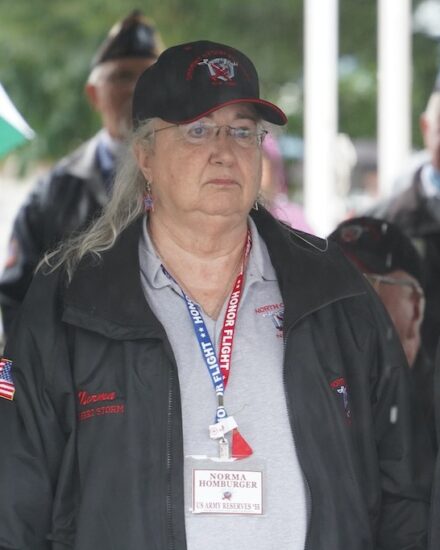 Norma Homburger, Veteran Guardian for her husband John,
Norma Homburger, Veteran Guardian for her husband John,
U.S. Army Reserves, 1974-1996 – Desert Storm
Norma’s career began as an LPN Medic in a 3-Tent Field Hospital in Malone. Norma trained with an M-16 rifle at Fort McClellan and received a Sharpshooter Badge. Norma was sent to Fort Devins and worked in tents like the MASH M-1934 Pyramidal Tent. During Desert Storm, Norma spent three months on the Walter Reed Army Hospital surgical ward. Tim McGraw visited the wounded veterans. Norma said she got paid once for getting in, twice for staying, and once for getting out! She was promoted, but the Army Reserves had no job for her. Norma served our Country for 22 years of medical service.
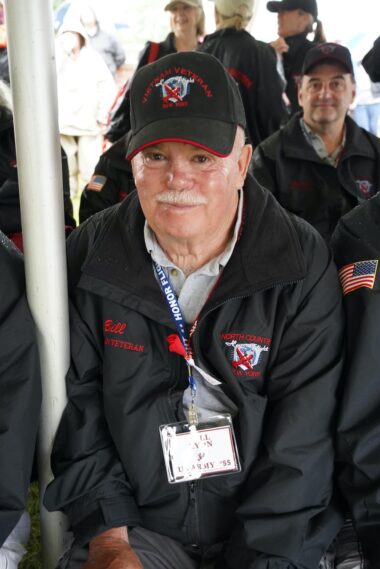 William Lyon, U.S. Army, 1970-1971 – Vietnam
William Lyon, U.S. Army, 1970-1971 – Vietnam
Drafted, Bill had basic training at Fort Dix and AIT Infantry Rifleman training at Fort Polk. Deployed to Vietnam, with two months experience, Bill’s Sergeant made him the point man. Bill found five enemy booby traps within 100 yards of each other within a half hour while on a mission with his unit. Bill saved many lives as they continued northwest to Chu Lai. Bill was asked to return to train the troops. His mother sent a letter saying she wanted her only son home. Mom won that one! Bill liked the fruit cake C-rations, and his family still buys him mini fruit cakes and fruit cocktails.
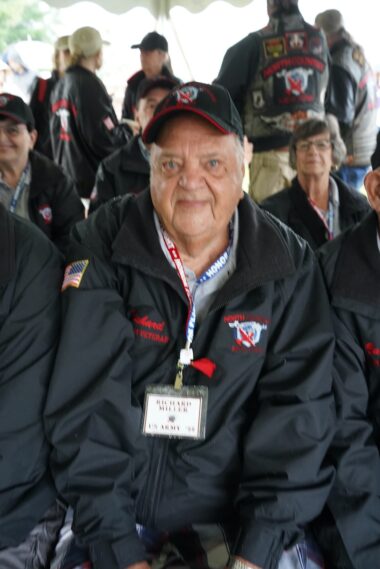 Gerald Richard Miller, U.S. Army, 1960-1980 – Vietnam
Gerald Richard Miller, U.S. Army, 1960-1980 – Vietnam
Richard had basic training at Fort Benning and AIT Food Service at Fort Dix. Richard prepared and served 1,000 people per meal, four lines deep in the mess hall. Richard estimates he served tens of thousands of military service members. Richard was in the 9th Infantry Division during the Tet Offensive. Army troops were on defense as communists attacked 64 district capitals. Pallets were dropped by helicopter as Richard distributed C-rations for seven days. Gerald received a Purple Heart and many other commendations for his 20 years of service. Heading to Vietnam, Richard and his wife Linda were married 57 years ago.
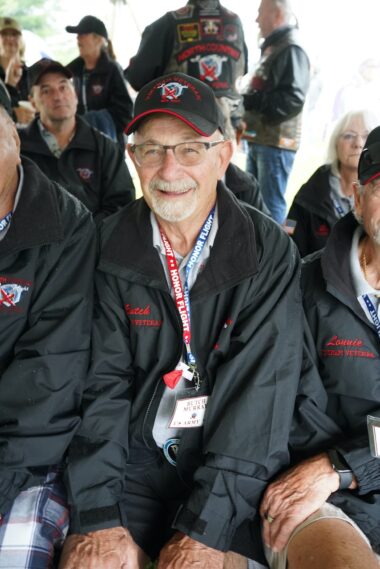 Roger Murray, U.S. Army, 1965-1967 – Vietnam
Roger Murray, U.S. Army, 1965-1967 – Vietnam
Drafted, Butch trained at Fort Dix and Fort Devins. Butch joined the196th Light Infantry Brigade as a ‘ground pounder.’ On a ship for 30 days, through the Panama Canal, they arrived in Vietnam. At night, they set up tents. In the morning, they saw snakes coming out of ant hills. On the Saigon River, they covered with blankets to keep rats and snakes off. Transferred to the 25th Infantry Division, Butch was wounded, hospitalized for 40 days, and sent right back into the field. Near the Cambodian border, they called air strikes to stop the Viet Cong about 150 meters away. Butch remembers jungles, rice paddies and C-rations older than him.
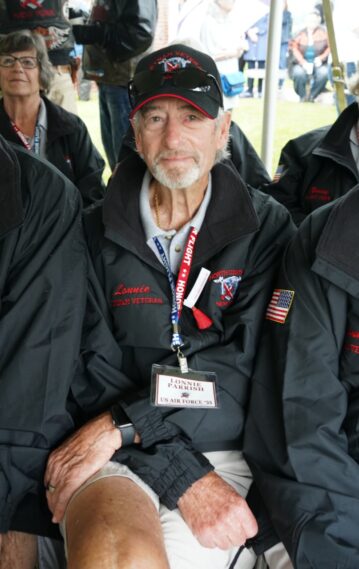 Lonnie Parris, U.S. Air Force, 1967-1975 – Vietnam
Lonnie Parris, U.S. Air Force, 1967-1975 – Vietnam
Lonnie trained at Webb Air Force Base as an airline fighter pilot. At McConnell Air Force Base, Lonnie trained pilots on F-16 and F-4 planes. Deployed to Vietnam, Lonnie flew F-4, F-105, and AT-33 fighter aircraft. Lonnie flew 360 Combat Missions. Lonnie received the Distinguished Flying Cross, numerous commendations, and Twenty-two medals for shooting down enemy planes. Lonnie also served 16-1/2 years in the Vermont Air National Guard. After Lonnie’s first tour in Vietnam, he and his wife welcomed their first child. After his second tour, they welcomed their second child. Lonnie’s wife, Susan, said he couldn’t serve a third tour.
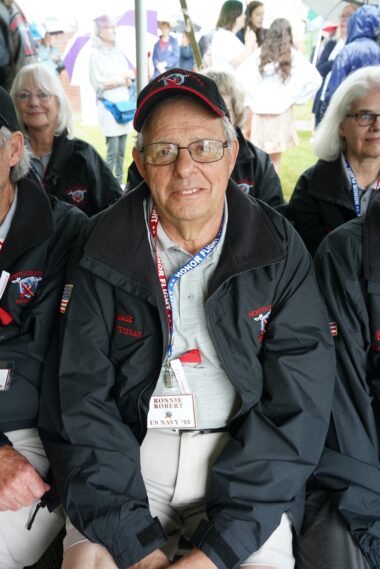 Ronald Robert, U.S. Navy, 1967-1970 – Vietnam
Ronald Robert, U.S. Navy, 1967-1970 – Vietnam
At the Great Lakes Naval Station, Ronnie trained in commissary, ordering, and supplying for combat, and he cooked. Aboard the USS Mount Baker (AE-4), an ammunition ship, Ronnie serviced aircraft carriers, battleships, and destroyers. Ronnie did four tours between the Philippines and Vietnam. Ronnie was aboard the USS Tawasa (ATF-92) as they rescued the USS Evans (DE-1023), towing the aft section to port. Ronnie and a friend raced rickshaws in Hong Kong; the winner kept the money. Crossing the equator, Ronnie became a shellback, a Navy ritual, and he saw the World’s Fair in Japan.
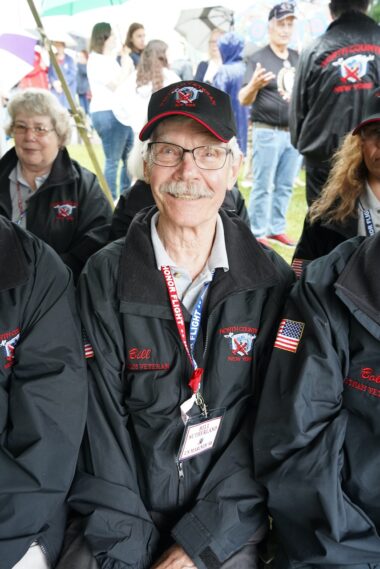 William Sutherland, U.S. Marine Corps, 1966-1969 – Vietnam
William Sutherland, U.S. Marine Corps, 1966-1969 – Vietnam
Bill enlisted, had basic training at Parris Island, and then AIT at an electronics school in San Diego. Deployed to Vietnam for 19 months, Bill was a Ground Radio Repairman. On his 20th birthday, Bill noticed a small sailboat as its lone occupant (Bill Shaw) was thrown into the churning seas. With disregard for his own safety, Bill, fully aware of the dangers, plunged into the water and located the unconscious occupant. With great difficulty, Bill rescued and saved Shaw’s life. The Navy presented Bill with the Navy-Marine Corps Medal for his heroism.
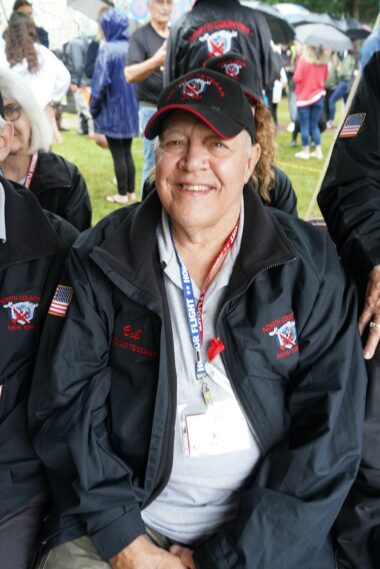 Robert Titus, U.S. Army, 1964-1966 – Vietnam
Robert Titus, U.S. Army, 1964-1966 – Vietnam
Drafted, Bob had basic training at Fort Dix and trained at Fort Campbell, assigned to Company C Engineering. Handling heavy equipment, Bob trained to build roads, bridges, and airstrips and learned demolition. He was scheduled for Vietnam, but a basketball injury sent him to the hospital. At Fort Campbell, the companies took turns receiving veterans killed in Vietnam and handled their burials, making the War real. While hospitalized with leg issues, Bob came face to face with injured veterans. Hard to deal with. Bob served as an Honor Guard for his local American Legion and was named Legionnaire of the Year in 2011.
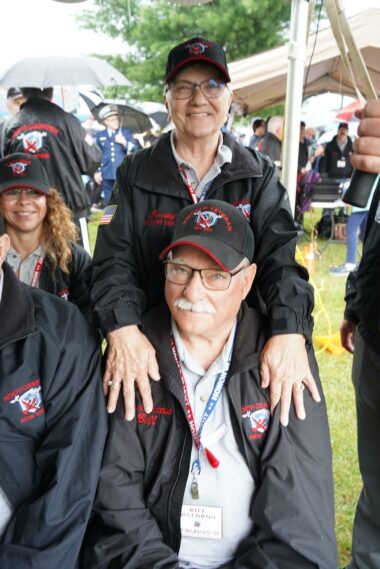 William Waldron, U.S. Marine Corps, 1969-1975 – Vietnam
William Waldron, U.S. Marine Corps, 1969-1975 – Vietnam
Drafted, Bill and a friend stood in line in Albany. His friend asked Bill to switch places, putting Bill last in line. The officer took the first, middle, and last people, so Bill became a Marine. Bill had basic training at Parris Island, became a Combat Engineer at Camp Lejeune, and completed Land Mine Warfare School at Camp Pendelton. Deployed to Vietnam, Bill, at Booby Trap School, was told if he found a mine, blow it up. Bill was aboard the USS Louis (LCS-19) for a month. Back stateside, Bill was released early because he was drafted. Bill said about his experiences, “I just went with the flow.”
Posted: June 24th, 2024 under Adirondack Region News, City News, Community Events, General News, Honor Flights, Northern NY News, Peru/Regional History, Regional NY-VT News, Veterans' News.
